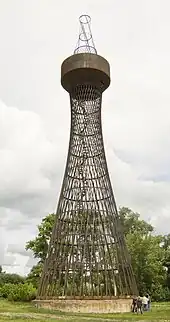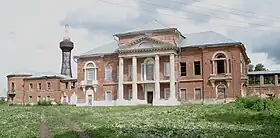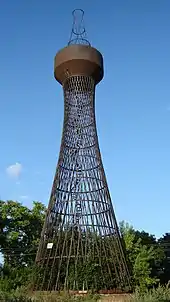Structure hyperboloïde de Polibino
La structure hyperboloïde de Polibino est une tour à claire-voie réalisée en treillage d'acier qui constitue la première structure hyperboloïde du monde[1] - [2] - [3] - [4]. Cette tour hyperboloïde a été construite pour l'exposition panrusse de 1896 (en) à Nijni Novgorod par l'ingénieur et scientifique russe Vladimir Choukhov. La tour est par la suite achetée, démontée et reconstruite dans le village (selo) de Polibino dans le raïon de Dankov de l'oblast de Lipetsk, en Russie où elle est toujours visible.

La première structure hyperboloïde par Vladimir Choukhov, Nijni Novgorod (1896)

La première tour Choukov à Polibino (2009)
Voir aussi
Bibliographie et sources
- (de) Rainer Graefe : Vladimir G. Šuchov 1853-1939 - Die Kunst der sparsamen Konstruktion, S.192, Stuttgart, DVA, 1990, consultable en ligne.
- (en) Arkhitektura i mnimosti: The origins of Soviet avant-garde rationalist architecture in the Russian mystical-philosophical and mathematical intellectual tradition, essai sur l'architecture, 264 p., University of Pennsylvania, 2000.
- (it) Fausto Giovannardi : Vladimir Shukhov e la leggerezza dell'acciaio sur costruzioni.net
Notes et références
- (de) P.110-114, «Vladimir G. Suchov 1853—1939. Die Kunst der sparsamen Konstruktion.», Rainer Graefe, Ph. D., und andere, 192 S., Deutsche Verlags-Anstalt, Stuttgart, 1990, (ISBN 3-421-02984-9)
- (en) «The Nijni-Novgorod exhibition: Water tower, room under construction, springing of 91 feet span», «The Engineer», № 19.3.1897, P.292-294, London, 1897.
- (en) «Arkhitektura i mnimosti»: The origins of Soviet avant-garde rationalist architecture in the Russian mystical-philosophical and mathematical intellectual tradition", Elizabeth Cooper English, Ph. D., a dissertation in architecture, 264 p., University of Pennsylvania, 2000.
- (en) Vladimir Shukhov and the Invention of Hyperboloid Structures
Lien externe
Photos

 Vue du château de Polibino en 2009
Vue du château de Polibino en 2009
 2006
2006 2008
2008 2008
2008
Cet article est issu de wikipedia. Text licence: CC BY-SA 4.0, Des conditions supplémentaires peuvent s’appliquer aux fichiers multimédias.